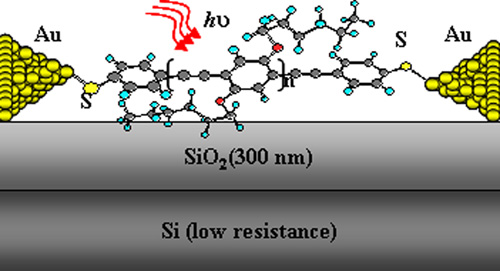| |
Wenping Hu,* Hiroshi Nakashima, Kazuaki Furukawa, Yoshiaki Kashimura, Katsuhiro Ajito, Yunqi Liu,* Daoben Zhu* and Keiichi Torimitsu
Nanometer scale devices, as the next generation devices of Electronics, have got a worldwide attention and rapid development recently. Simultaneously, conjugated polymers have been applied in Organic Electronics successfully because of their outstanding electronic-photonic properties. However, as far as we know few reports have dealt with the fabrication of nanometer scale devices by using conjugated polymers, although the combination of nanometer scale devices and polymers will not only extend conjugated polymers to Nanoelectronics, but also excavate the behaviors of polymer molecules at nano/molecular level, such as the electron transport through polymer molecules.
Poly(para-phenylene ethynylene)s (PPE) is expected with not only ideal conductivity, but also ideal rigidity. Moreover, by modifying PPE with thiol/thioacetyl-end-functionalized groups, provides good prospects for applying this thiol/thioacetyl-end-functionalized polymer for self-assembled nanoelectronic devices. Here, we synthesized a derivative of PPEs with thioacetyl end groups (TA-PPE, Figure 1), which exhibited ideal rigidity and connectivity with Au. Depending on the ideal conductivity, rigidity (for wiring and bridging between electrodes) and connectivity (for covalent attachment to metallic surfaces), gold nanogap electrodes and gold nanoparticles could be connected by TA-PPE molecules by self-assembly to form nano devices. With photo irradiation the device could be switched on/off quickly as a nanoswitcher with a switching ratio as high as 1000. Moreover, the device can be worked well as a p-type transistor. With gate bias increasing, strong conductance oscillation was observed in this self-assembled transistor (under low temperature 147 K), which is very likely due to single-electron charging oscillations arising from electron tunneling through the nanometer scale transistor (Figure 2).
J. Am. Chem. Soc. 2005, 127, 2804-2805.

Fig.1 Molecular structure of TA-PPE, here n is around 70.

Fig.2 Self-assembled nanodevices of TA-PPE. , |
|
